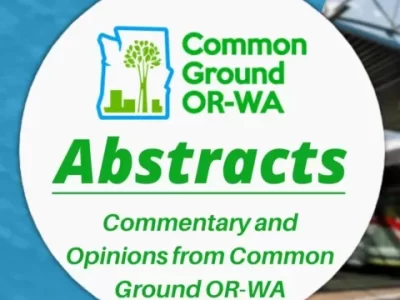Commentary on the HPAC Work Group Recommendations, by Common Ground-OR/WA
2023 Oregon HPAC Recommendations and Comments from Common Ground OR-WA (PDF)
A basic principle in liberal economic theory holds that legitimately created value belongs to the creator of that value. Land value is created cumulatively by the community as a whole, and as such belongs to the community; building value is created by private capital, and as such, belongs to the owner. Hence, government is justified in recapturing by means of property taxation what it has “given.”
In this sense, a returned “giving” does not result in relinquished revenue. On the other hand, property tax exemptions, the favored relief method of elected officials, are not revenue neutral. Over the past several years they have shifted the tax burden from the business sector (having received the majority of tax breaks) onto households.
Land value taxation (LVT) is based upon the principles advocated by 19th Century political economist Henry George. The theory of land taxation holds that a property tax based upon site values provides an incentive to bring land into productive use; simultaneously, a reduction or abolition of taxes on site improvements should encourage more efficient land use.
This theory was subsequently incorporated into law in several British Commonwealth countries, as well as in Taiwan, Denmark, Estonia, and in the U.S. state of Pennsylvania. Thus far, no U.S. public entity has taxed solely the value of land – the “single tax”. In all instances where the split-rate form of LVT has been adopted, land values are taxed at a higher rate than building values.
Under the present equal rate taxation system, owners have no financial incentive to improve property because a higher tax liability will result from taxing the building improvements. Unless the property tax system is allowed to shift the tax rate off of building values onto land values by applying differential rates, the former outcome is inescapable. The Sightline Institute’s Alan Durning states in his book Tax Shift: “Most northwest jurisdictions seek to prevent urban sprawl through the regulatory tools of land-use planning. Yet a simple reform to the existing property tax would turn it into a powerful incentive for investment.”
By shifting taxes from capital investment onto land and natural resources the land value tax is a fairer tax. Taxing private use of land and natural resources keeps prices low and stable, broadening ownership and encouraging productivity (i.e. putting land to its “highest and best use”).
__________________
Common Ground OR-WA is a regional chapter of Common Ground USA (commonground-usa.net), a 501(c)4 non-profit organization, committed to reducing and replacing taxes on labor and capital, and to appropriate the value of land and other natural resources to pay for essential government services. For more than ten years, we have been conducting research on land-based taxes, and actively promoting state legislation to reform the existing property tax system.
A property tax reform bill, designed as a split-rate variation of the land value tax was introduced (SJR-1) in the 2005 legislative assembly. The bill proposes amending the state constitution to allow the taxation of land and improvements at differential rates. By repealing Measures 5 and 50, a reformed tax system would base tax collections on true market assessments. More recent drafts of a tax reform bill have evolved into an LVT study bill and a local option LVT.
We are pleased that the Tax Reform Working Group recognizes the failure of Measures 5 and 50 to bring equity and fairness to Oregon’s property tax. It also acknowledges that limiting assessments and tax rates fails to provide adequate local government revenue and encourage development of needed housing. We agree with all the recommendations of the Working Group, with one exception:
We do not believe that increasing the annual Maximum Assessed Value change to 5% will achieve meaningful results. The Legislative Revenue Office’s RESEARCH REPORT #4-15: Analysis of Options for Restructuring Oregon’s State and Local Revenue System found that Measure 50 created a rigid, inflexible system leading to horizontal inequities for taxpayers – the unequal tax treatment of taxpayers with similarly valued property. This inequity is caused by the divergence of assessed value from real market value. When general home prices rise, horizontal inequities can increase over time. Land values in some neighborhoods within a county grow more rapidly than others.
The Northwest Economic Research Center, College of Urban and Public Affairs, Portland State University, FINAL REPORT: Oregon Property Tax Capitalization: Evidence from Portland, March 2014, confirmed the inequities of the system based on differing rates of changes between maximum assessed value (MAV) and real market value (RMV). The study found that differences in property tax payments are having a significant effect on sale price. Houses that have experienced large growth in value since the inception of the current system tend to be paying less as a percentage of their homes’ value in taxes, which increases sale price. This disproportionately benefits property owners who can afford to buy in areas with faster increases in property values. This report focuses on Portland, but this same dynamic is likely at play in the rest of the state.
We have to conclude that the MAV system by any means of contrivance is problematic. When authorizing additional taxes at the local level whether by voter approved bonds, local option levels, or newly created special districts, the effects are sporadic and stop-gap at best. Measure 5 also constrains the ability of local jurisdictions to raise tax revenues.
The HPAC Work Group is clear in its diagnosis: Oregon’s property tax system disincentivizes improvements to real property; eliminating the disincentive will lead to the creation of more housing units. LVT is the clear path to this objective.
A reduction in tax rate on improvement assessments would facilitate the renewal and replacement of obsolete buildings in a region’s central cities. Property owners, responding to the fiscal inducement to reduce the land-to-building value ratio, would build more intensively on vacant and underutilized sites. Stagnating local business districts, including historic “main streets,” could be revived under the land value tax.
The 2-rate tax would discourage land speculation, or holding unimproved or under-improved property for the purpose of reselling without making substantial capital investments. A sufficiently heavy land tax would deplete cash reserves from the holdout owner. As a result of placing proportionately higher taxes on land, it would become too costly to hold onto vacant or underutilized centrally located sites. A trend would emerge toward infill development and a gradual re-centralization of urban development. Simultaneously, there would be a diminishing demand for peripheral sites at the urban fringe.
Because the differential-rate tax is applied uniformly to all properties within a jurisdiction, the general effect would be a restraint on rising land prices, leading towards greater housing affordability. When the land tax encompasses an entire housing market, there is a general downward pressure on location rents. This occurs because the higher tax on land values is capitalized into lower residential land sales prices.
These propositions have been supported by several independent studies conducted by LRO, PSU’s NERC, Common Ground-OR/WA, City Club of Portland, Portland METRO, and Institute of Public Policy & Management, University of Washington. These studies cover the jurisdictions of Portland, Multnomah & Washington counties, Salem-Kaiser, Clark County, King County, and Washington State.
The adoption of LVT requires amending Oregon’s constitution because Measures 5 and 50 were inappropriately baked into the constitution, effectively changing a revenue-based property tax system to a mostly rate-based system, and shifting the burden of funding primary and secondary education from counties to the state government. A second constitutional barrier is the uniformity clause, which is regrettably interpreted to treat land and improvements as different classes of property. An ordinary reading of the law would differentiate between classes of land use, not two components of property. This precludes the use of split rates on land and improvements.
Common Ground-OR/WA has proposed a constitutional amendment authorizing a local option LVT, whereby counties or cities may by popular vote switch to a split-rate LVT system and be granted an exemption from Measures 5 & 50. We encourage the HPAC Work Group to explore this route.
HPAC recommendations state the need to follow constitutional changes with a state statute prescribing the mechanisms of LVT. We too recommend that the legislature draft the referrals. Since Common Ground-OR/WA has already prepared draft language for previous LVT bills with some success in garnering legislators’ support, we recommend that HPAC examine these texts.
We too have stated that significant work will be required by county assessors to adjust assessment systems and methodologies. Georgist organizations around North America, most especially in Pennsylvania, have firmly expressed the need for accurate and up-to-date property assessments, which is the only way that the built-in incentives of LVT can become effective. In fact, Common Ground-OR/WA has prepared language for a Best Practices Assessment bill, refining details with suggestions from Oregon Department of Revenue staff.
We too recognize the need for a gradual phased-in approach over several years during which the ratio of land/improvement values for tax calculations trend to 100 percent. This is precisely what we have been developing over the past several years – a six-step process, including buffered phase-out / phase-in from MAV to RMV assessments over a 5-year period, as well as a homestead exemption and tax deferral to minimize the burden of a precipitous increase in tax liability for some homeowners.
It is clear that a change to LVT will have to be revenue neutral, meaning that the combined split-rate applied to RMV assessments will likely be lower than the existing rate for MAV assessments. All simulation modeling that we have performed or reviewed incorporates this assumption. However, a change back to a revenue-based tax system will require some method of limiting revenue growth – out of political acceptability and popular consent. Washington State, using RMV assessments, uses the standard system of limiting annual revenue increases to a given percentage; other factors can be added such as population growth and cost of living increase.
Finally, the HPAC Recommendation Template included a NERC citation: Northwest Economic Research Center, Land Value Tax Analysis: Simulating the Effects in Multnomah County, June 2019. It is worth noting that Common Ground-OR/WA commissioned this study, with the financial support of Oregon Community Foundation, and Schalkenbach Foundation. The report’s conclusion states:
“Ultimately, land-based property tax systems, whether a split-rate LVT or a building exemption tax, are found to achieve what they are designed to do—place more of the tax burden on wealthier landowners and encourage the highest and best use of land. An LVT would provide a more equitable tax structure, incentivize building upgrading and development of underutilized properties, and discourage “holding” land for speculative purposes.”
Common Ground – OR/WA
commongroundorwa.org




